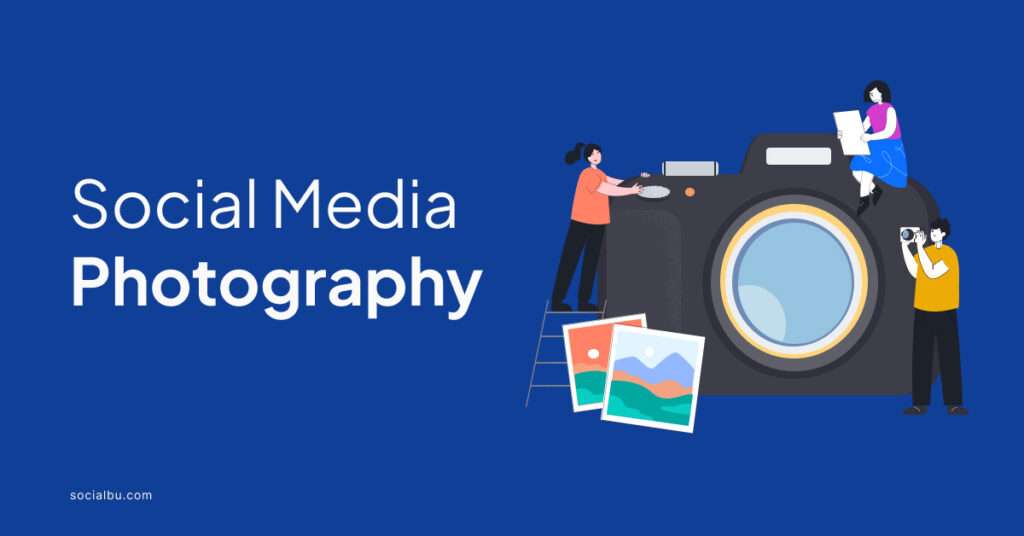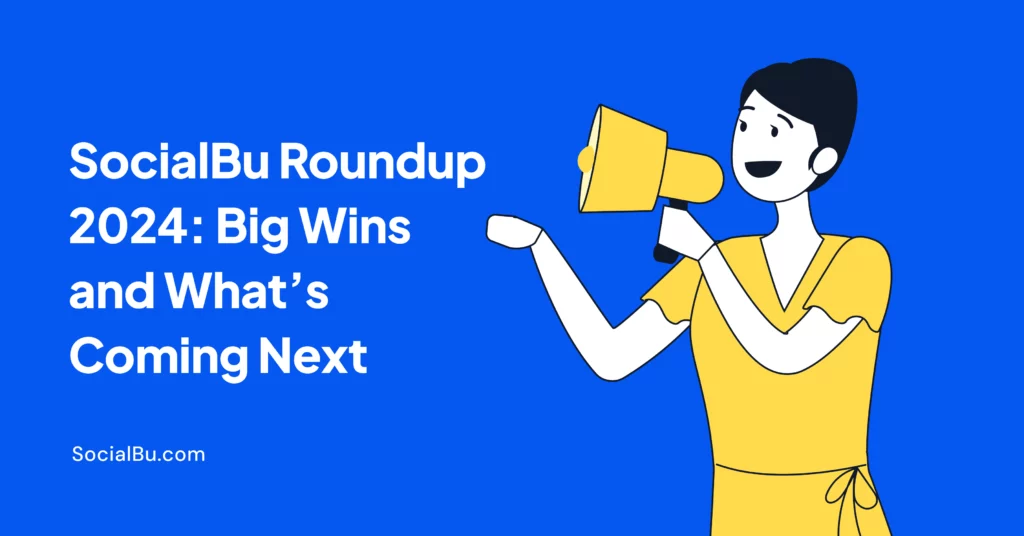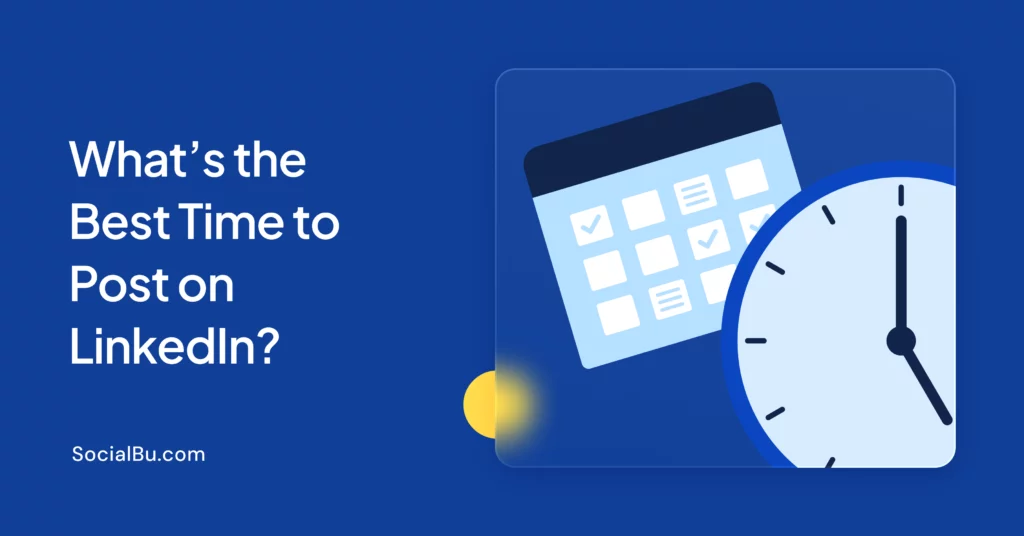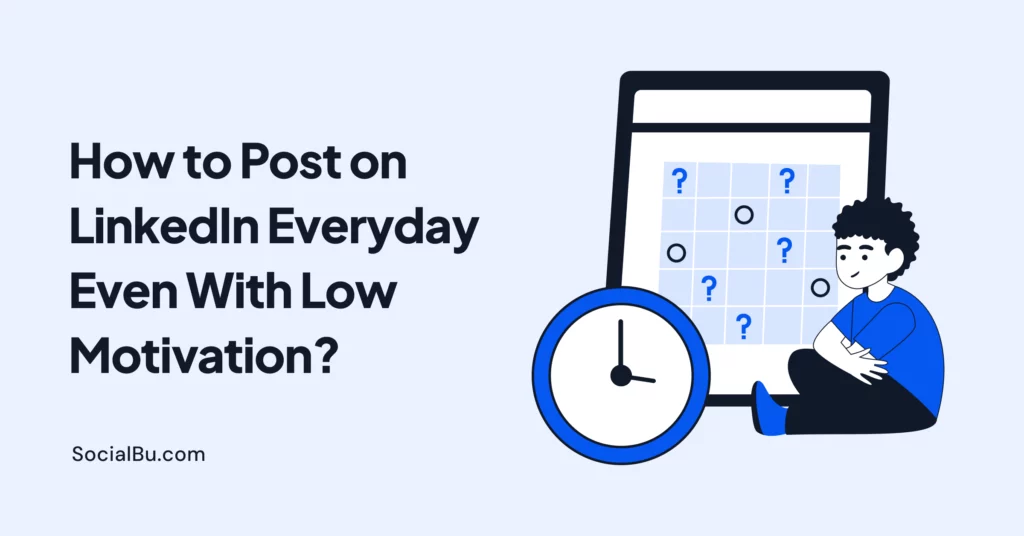Social media photography and content are both crucial to converting visitors into potential traffic and landing on business websites. But how do you ensure your business or products’ social media photography entices the audience to scroll more and stick to your company? You can do it by providing high-quality images, eliminating imperfections, maintaining consistent branding, etc.
In this article, we’ll explore:
- The importance of professional social media photography for your brand.
- Different techniques/ways to create engaging and high-resolution product photos.
- Which social media platform do you choose for your business and why?
- Different social media platform image sizes.
- Tactics to optimize images for different social media platforms.
- Importance of photo editing and post-processing for social media photos.
So, without more intros, let’s head to the article now!
What is Social Media Photography?
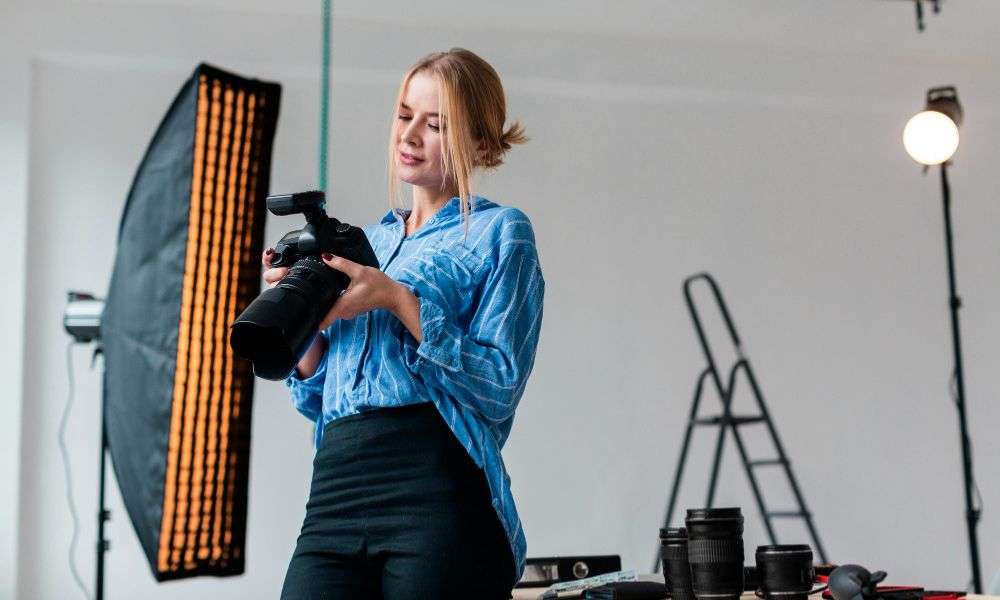
Social media photography refers to capturing high-quality images designed for social media platforms like Instagram, Facebook, Twitter, TikTok, Pinterest, LinkedIn, and so on.
It focuses on visually appealing compositions and aesthetics to build engagement with social media users, promote brands, and communicate a specific message. Different types of social media photography exist, such as product, lifestyle, event, portrait, food and beverage, and more.
Key aspects of social media photography:
- Photos are optimized for social media platforms.
- Photos are designed to promote a brand or service, showcase a brand’s unique perspectives, or tell a story.
- Maintain a consistent look and feel that matches the brand’s identity, such as color schemes, themes, and filters.
- High-quality social media photos encourage likes, shares, and comments that increase organic reach.
How Can Professional Social Media Photography Benefit Your Brand?
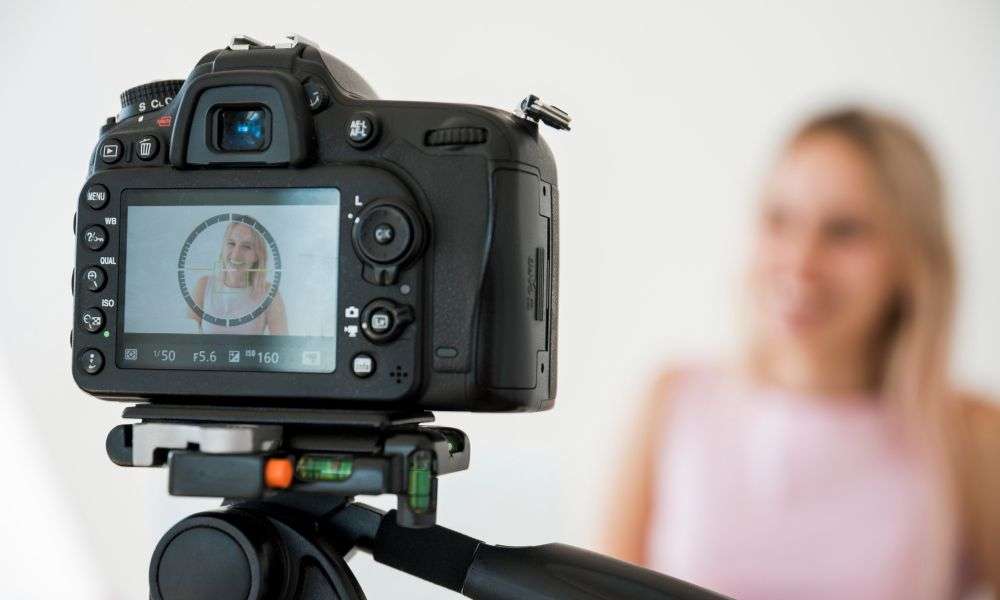
Professional social media photography can benefit your brand by enhancing its visual appeal, building trust and credibility with potential customers, attracting more engagement on social platforms, and establishing brand identity across all digital channels.
In 2024, BusinessDasher stated that high-quality product photos had a 94% higher conversion rate than low-quality photos. On the contrary, 22% of returns happen due to the product visuals in person.
Let’s take a look at the key benefits of professional and high-quality social media photography below:
- Improves engagement: Professional social media photographers provide eye-catching visuals that increase likes, shares, and comments.
- Drives conversions: Professional brand social media photography helps to increase sales and conversions from your social media to your website.
- Enhances brand perception: Clear, consistent, high-quality images convey credibility and foster a deeper connection with your audience.
- Makes a strong first impression: Real estate photography for social media, social media food photography, automotive photography, or other businesses attracts potential customers by representing professional images.
- Differentiates from competitors: Polished, proper lighting, blur-free, and high-resolution images steal social media users’ hearts at a glance, which makes all the difference.
How Can You Make Product Photos More Engaging for Social Media?
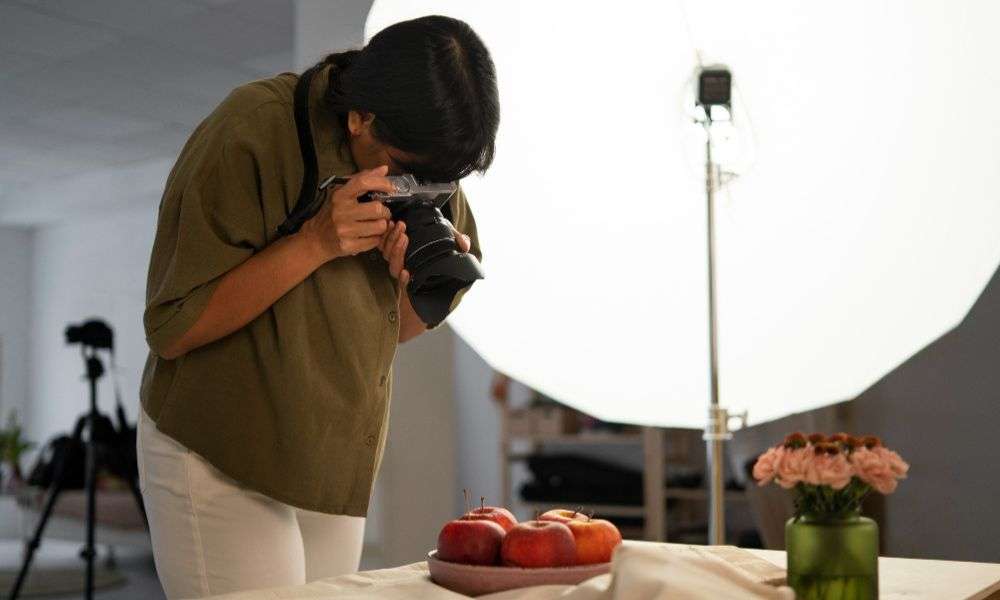
To make product photos more engaging for social media platforms, choose the best cameras for social media photography, select high-quality and proper lighting, clean backgrounds, shoot multiple angles, and close-up shots to highlight features, maintain consistent branding, try to portray a story, and edit photos for social media to fit perfectly.
Here are some key strategies that ease your photography process for social media:
- Camera for social media photography: For high-resolution and amazing social media photography, you can use mirrorless cameras or high-end point-and-shoot cameras like the Sony RX100 series, Canon G7X Mark III, Canon EOS R50, or others.
- Lighting and compositions: If you plan to shoot outdoor photos, choose the Golden Hour for eye-soothing and distraction-free images.
- Multiple angles: Try to provide different angles, such as 360-degree or 45-degree angles, eye level, overhead, or other products, to showcase unique features and add visual interest. For example, Amazon, Walmart, etc.
- Close-up shots: Close-up shots are the best option when you plan to showcase intricate details of your product.
- Background and styling: Use a simple, clean background, and relevant props to create a story around your product and engage audiences through real-life usage.
- Brand consistency: Maintain a consistent color scheme to reinforce brand identity and apply consistent editing techniques.
- Optimize for each platform: Facebook prefers eye-catching visuals with minimal text for better results. Instagram uses square or vertical images for feed posts and stories and leverages carousels. Pay attention to specific social media platforms to fulfill image requirements and maintain social media photo quality on different screens.
What to avoid for social media photography?
For social media photography, avoid overly cluttered backgrounds, excessive props, poor lighting, inconsistent framing, blurry images, and showcasing only a few of the product’s key features.
What Social Media Platform is Best to Promote Your Product or Brand?
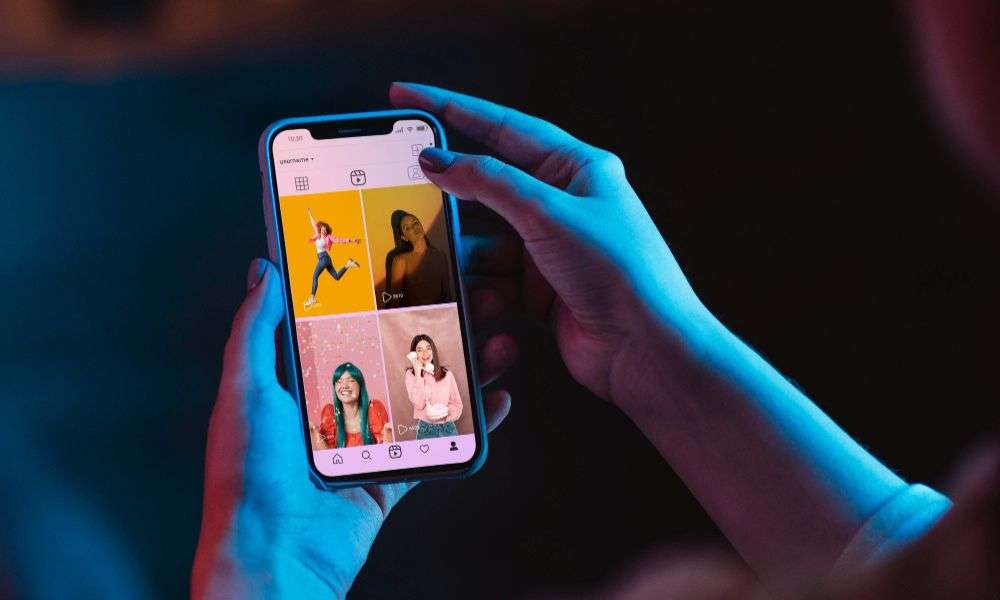
Facebook, Instagram, YouTube, LinkedIn, Twitter, Pinterest, and TikTok are the best social media platforms to promote your product or brand. If you’re a B2B brand, LinkedIn will be the best fit for building connections with professionals and brands. So, before choosing the best social media platform for your business, ask yourself:
- Am I a B2B or B2C company?
- Who’s my ideal customer/target market?
- What’s my ultimate goal? Is it to sell, to connect, or to build brand awareness?
Below, we’ve showcased a table highlighting different social media platforms’ key purposes and target audiences.
| Platform | Purpose | Target Audience |
|---|---|---|
| Portfolio showcase, stories, and engagement | Young adults, fashion, lifestyle | |
| Community building, event promotion, behind-the-scenes | Broad demographic, local communities | |
| Image curation, inspiration boards | DIY enthusiasts, decorators | |
| Industry news, real-time interactions, announcements | Media, influencers, other professionals | |
| TikTok | Creative short videos, trending challenges | Younger demographics, creative niches |
| Networking, B2B engagement, professional branding | Professionals, business clients | |
| YouTube | Brand awareness, monetization, generating leads | People of all ages and backgrounds |
Instagram for business
In 2024, Statistica reported that Instagram had two billion active users worldwide monthly, and 85% of its audience was younger than 45. Like Facebook, Instagram is popular for its Stories (posts that last 24 hours) and Reels (short video content) features.
Also, its shopping features make business more effective. For example, @summerfridays shared its business website link with the shop link for Sephora. You can upload short, creative videos, interactive stories, carousels, and create polls or others.
Key features of Instagram shop:
- Collections based on a theme (i.e., new arrivals, colors, etc.)
- Product detail pages (pricing, descriptions, and content where the product is tagged)
- Product tags and product Ad tags
- Checkout for payment.
Facebook for business
It is popular for its extensive reach, targeted advertising options, robust community-building, and engagement. Facebook groups provide insights into what customers want and help you to connect with loyal customers.
You can publish different content types such as video content (live video) to show off products, how-to tutorials, provide industry or company news, host live Q&As, user-generated content, etc.
Key features of Facebook business page:
- Allow users to add contact information, hours of operation, and location information.
- Create a “Shop Now” or “Learn More” call-to-action button.
- Allow the use of company logos, cover photos, and more.
- Facebook Business Manager (allows to handle multiple pages or multiple ad accounts)
- Facebook Ads Manager (manage and edit content, audience, budgets, etc.)
- Facebook Commerce Manager (sell products, manage sales, inventory, insights, and financial reports)
Pinterest for business
As the world’s 15th most-used social media platform, over 1.5 billion pins are saved weekly on Pinterest [Source: Pinterest Newsroom]. With a Pinterest Business account, you can drive traffic by linking to your site.
Promote products and create “catalogs” by posting “Pins” that link to your feed. You can also upload shoppable items.
Key features of Pinterest business page:
- Pinterest paid ads or promoted rich pins: App pins, Article pins, Recipe Pins, and Product pins.
- The Verified Merchant Program includes a verified badge icon, product price, availability on pins, a shop tab on the profile, etc.
- Pins with images or videos.
- Multiple boards based on different themes or interests.
- Save button.
- Shopping features like Buyable Pins and Shopping Ads.
- Pinterest Business Manager with multiple Pinterest accounts and campaigns.
- Pinterest Professional profile.
Twitter for business
From 2019 to 2024, Statistica stated that X’s (formerly Twitter) monthly active users were between 335 million and 666 million. Many brands prefer to use Twitter as an alternative customer service channel.
In 2016, Twitter advertisers showcased more than 80 percent of social customer service requests on Twitter, and Salesforce calls this social media channel the “New 1-800 Number for Customer Service.”
Key features of Twitter business page:
- Twitter Spaces directly interact with followers and ask for feedback.
- Live Tweeting connects with followers in real-time, answers questions, and shares funny and exciting moments.
- Twitter communities are private groups where you can post tweets and replies visible only to community members.
- Twitter lists help to organize followers into groups based on industry or interests.
- Promoted Tweets are paid ads that interact in the same way as organic content.
TikTok for business
TikTok is a fascinating home to over 1.5 billion users of all ages [between 25 and 44 years old]. Most businesses and brands utilize this platform to run different TikTok ads, collaborate with TikTok influencers, and grow overall business.
Key features of TikTok business page:
- Lead generation: We can help you collect leads with flexible forms on your profile, videos, and LIVE events.
- Analytics: You can track growth, content performance, audience demographics, and LIVE engagement in Business Suite.
- Creative hub: Get content inspiration and industry trends in the Business Suite.
- Post scheduler: You can schedule your TikTok posts up to 10 days in advance.
- Interaction management: Auto messaging suite, web comment and messaging interface, profile contact attributes, and organic geo-targeting.
LinkedIn for business
Do you know LinkedIn is the top content distribution channel for 94% of B2B marketers? Yes, it’s true. With 756 million members and one billion interactions monthly, it is a win-win platform for your business.
Key features of TikTok business page:
- LinkedIn Stories lets you express your business stories, overlay text to your product video or image, and more.
- Featured posts allow you to either link to content you’ve created on the web, or upload media like PDFs, slide decks, photos, etc.
- LinkedIn Polls are an incredible engagement tool for getting quick feedback from your audience and offering the best.
- LinkedIn organic “carousel” posts connect customers and allow them to scroll through them.
- LinkedIn Live is a trendy social media marketing hack that receives up to 7x more reactions.
YouTube for business
YouTube, the trendy video platform, has over 2.5 billion active users. It allows you to promote your brand, connect with potential traffic, and increase revenues. In 2024, SemRush stated that YouTube videos appeared on search engine results pages (SERPs) for over 791 million search queries.
Key features of TikTok business page:
- YouTube Live has a dedicated feed that expands your reach.
- YouTube Live Chat creates a practical arena for fans and less stress for you.
- YouTube premieres allow you to build community through interactive content.
- YouTube channel dashboard, video editor, audio library, video spotlight, and more features build effective connections.
- Custom graphics, custom ads, and more are available on one platform.
How Do You Optimize Your Product Photos for Different Social Media Platforms?
You can optimize your product photos for different social media platforms by resizing images to fit each platform’s dimensions, using the correct image format (like JPEG for photos and PNG for transparency), and adding relevant alt text for SEO purposes.
Here’s an overview of image dimensions for different social media platforms:
| TikTok | |||||
|---|---|---|---|---|---|
| Profile Photo | 128×128 pixels | 320×320 pixels | 400×400 pixels | 200×200 pixels | 400×400 pixels |
| Landscape | 1200×628 pixels | 1080×566 pixels | 1600×900 pixels | 1920×1080 pixels | 1200×627 pixels |
| Portrait | 628×1200 pixels | 1080×1350 pixels | 1080×1350 pixels | 1080×1920 pixels | 627×1200 pixels |
| Square | 1200×1200 pixels | 1080×1080 pixels | 1080×1080 pixels | 1080×1080 pixels | 1080×1080 pixels |
| Stories | 1080×1920 pixels (9:16) | 1080×1920 pixels | N/A | 1080×1920 pixels | N/A |
| Cover Photo | 851×315 pixels [Recommended dimension] | N/A | 1500×1500 pixels | N/A | 1584×396 pixels |
Facebook image sizes
Pay attention to the ideal image file size for faster loading speed [less than 100KB].
- Facebook event cover photo dimension:
- 1200×628 pixels (2:1 aspect ratio)
- Facebook story’s image dimension:
- Leave 14% (250 pixels) of the top and bottom text-free, which allows you to represent CTA perfectly. Avoid choosing an image with a width smaller than 500 pixels.
- Facebook Ads photo dimensions are:
- Facebook feed ads: 1080×1080 pixels (1.91:1 to 1:1 minimum size should be 600×600 pixels).
- Facebook marketplace ads: 1080×1080 pixels (1:1 aspect ratio).
- Facebook search: 600×600 pixels (minimum size); the recommended image size is 1080×1080 pixels (1.91:1 to 1:1 aspect ratio).
- Facebook Messenger inbox ads: The required resolution is 1080×1080 pixels (the minimum width for the Stories ads is 500 pixels, and the aspect ratio is 9:16).
Instagram image sizes
The Instagram profile picture appears as a circle, so highlight the core elements you want to focus on in the center of the image. Remember that Instagram doesn’t allow followers to click on the profile picture to expand.
- Instagram story image size: 1080×1920 pixels.
- Instagram feed photo size:
- Landscape: 1080×566 pixels (1.91:1)
- Portrait: 1080×1350 pixels (4:5)
- Square: 1080×1080 pixels
- Instagram carousel photo size
- Landscape: 1080×566 pixels (1.91:1)
- Portrait: 1080×1350 pixels (4:5)
- Square: 1080×1080 pixels
- Instagram Ad’s photo size
- Landscape: 1080×566 pixels (1.91:1)
- Square: 1080×1080 pixels
- Min width: 320 pixels
- Max width: 1080 pixels
- Instagram stories ads: 1080×1080 pixels (9:16)
- Instagram reels ads: 1080×1920 pixels (9:16)
- Instagram profile feed ads: 1080×1080 pixels (1:1)
Twitter image sizes
Twitter profile image size 400×400 pixels (file size 2 MB). Other image sizes are:
- Twitter header image size 1500×500 pixels (3:1)
- Twitter in-stream photo size 1600×900 pixels
- Twitter shared a photo size of 900×450 pixels
- Twitter Ads image sizes are:
- Single and multi-image tweets: 600×335 pixels
- Website card image: 800×418 pixels
- App card image: 800×800 pixels
- Direct message card: 800×418 pixels
- Conversation card: 800×418 pixels
- Carousels: 800×800 pixels
TikTok image sizes
TikTok’s recommended profile image size is 200×200 pixels. Other image sizes are:
- Twitter video image size is 1080×1920 pixels (9:16 aspect ratio)
- TikTok carousel image size is 1080×1920 pixels
LinkedIn image sizes
LinkedIn recommends a profile picture size of 400×400 pixels with an aspect ratio of 1:1 and a file size of less than 8 MB. Remember, LinkedIn cover photos are cropped differently on desktop and mobile.
- LinkedIn Company page image size:
- Square logo size: 60×60 pixels
- Blog post image: 1350×440 pixels
- Logo size: 268×268 pixels
- LinkedIn cover image size:
- 1584×396 pixels (8 MB)
- LinkedIn post specs with a shared image or link:
- Square images: 1080×1080 pixels
- Portrait images: 1920×1080 pixels
- Shared link image: 1200×627 pixels
- LinkedIn carousel ads:
- Individual image size: 1080×1080 pixels
- Max image size: 4320×4320 pixels
Pinterest image sizes
The recommended image sizes:
- Profile photo: 165×165 pixels
- Profile cover photo: 800×450 pixels (16:9)
- Square pin image size: 1000×1000 pixels
- Story pin image size: 1080×1920 pixels (9:16)
- Collection pin image size: 1000×1000 pixels or 1000×1500 pixels
- Ads and carousels image size: 1000×1500 pixels or 1000×1000 pixels
- Pinterest Shopping ads: 1000×1500 pixels
- Pinterest board display image: 222×150 pixels (large thumbnail) & 55×55 pixels (smaller thumbnail)
| Pinterest text guidelines: 100 characters max and textbox character count 250 (max) |
|---|
YouTube image sizes
YouTube video profile image sizes are:
- 800×800 pixels
- YouTube Channel covers photo dimensions:
- Recommended file size: 2560×1440 pixels
- Minimum file size: 2048×1152 pixels
- Mobile and web (without text and logo cropping): 1546×423 pixels
- YouTube Banner image size:
- 2048×1152 pixels (16:9)
- YouTube video guidelines:
- YouTube Shorts: 1920×1080 pixels (9:16)
- YouTube Thumbnail photo: 1280×720 pixels (16:9)
Other product photo optimizing factors for social media platforms are:
- Image format: JPEG, PNG, and GIF are commonly used file formats in social media photos.
- Attachment details: Ensure the details contain the title, description, and alt tags.
- SEO-based optimization: SEO or search engine optimization ensures your product images are best for e-commerce purposes:
- Image file name: Use specific product photo file names that summarize the product/subject for on-page SEO rankings. For example, red-color-crossbody-bag.jpg
- Alt tags: Add alt text and tags to your image to tell search engines what it is, even if the image doesn’t load properly.
What Is the Importance of Editing & Post-Processing for Social Media Photos?

Editing and post-processing for social media photos are essential to enhance product/service visuals quality, attract target audience, and boost ROI. You may also overlay two images to add depth, texture, and narrative to your photographs, making them stand out in a crowded social media feed.
High-end photo retouching involves different editing techniques, such as color correction, shadow creation, unwanted object removal, image cropping, resizing, filtering, and presets, which refine images to resonate with different social media platforms.
Why image post-processing or photo editing matters?
Here are the key reasons why:
- Enhance image quality: Image post-processing improves image quality by adjusting brightness, contrast, saturation, sharpness, and reducing noise. Also, it adjusts the white balance for natural-looking colors and corrects imperfections like poor lighting, distracting elements, unwanted shadows, and more to make photos stunning.
- Maintain brand consistency: Photo retouching ensures product/service photos follow a consistent style, color palette, and tone, instantly making the brand recognizable and building trust among the audience.
- Platform-based optimization: Different social media platforms have specific requirements, such as image dimensions, resolutions, and formats. Professional photo editing ensures images are tailored to each platform, avoids awkward cropping or distortion, and loads faster without quality loss.
- Eliminate imperfections: Hand-drawn photo editing removes blemishes, distractions, or unwanted social media photo backgrounds/objects from a photo, giving it a polished and professional look.
- Maintain mood and atmosphere: Image post-production emphasizes key elements of a photo by adjusting vignettes, selective coloring, utilizing social media photo backdrops, and focus effects to evoke specific emotions.
- Supports marketing goals: Image editing highlights key elements of a product/service, such as a product feature or a call-to-action, and ensures visuals align with your social media campaign’s messaging and goals.
- Improves engagement: Well-edited social media photos encourage audiences to scroll more, like, comment, or share. Also, high-quality visuals increase the visibility of featured or viral content.
- Saves time and money: High-end professional product retouching reduces the need for reshoots and saves time and resources. Also, you can use those for future use or repurposing.
You can invest time in post-processing or outsource high-end professional photo editing services from a renowned agency to transform ordinary photos into attention-grabbing ones that captivate your audience and reinforce your brand.
FAQs
How Much Do Social Media Photographers Charge?
Professional social media photographers may charge between $500 and $2,000 for a shoot, depending on the photographer’s experience, the number of images needed, the shoot duration, the photo quality, photography location, and travel expenses.
Is It Worth to Hire a Professional Photographer?
Yes, hiring a professional photographer for superior quality, specialized equipment, industry-grade experience, and artistic creativity in social media photos is worth hiring.
Can I use my smartphone for professional-looking social media photos?
Yes, you can use your smartphone to shoot professional-looking social media photos.
What type of photos perform best on social media?
Well-lit, high-resolution, and platform-based image sizes are best for social media platforms.
How can I measure the success of my social media photos?
You can measure the success of your social media photos by tracking metrics like impressions, reach, engagement rate (likes, comments, shares, etc.), click-through rate, conversion rate, and so on.
What are the best apps for editing social media photos?
The best social media photo editing apps are Adobe Photoshop, Canva, VSCO, and many others.
Conclusion
An effective social media marketing strategy means potential traffic on your business site and more revenue. But without high-quality images, you can’t win the game.
So, what are you waiting for? Follow our e-commerce-worthy image-capturing tactics to craft social media photography that converts, and remember to edit photos to fulfill the requirements of your target marketing channel!
